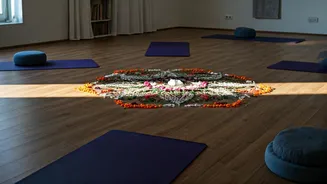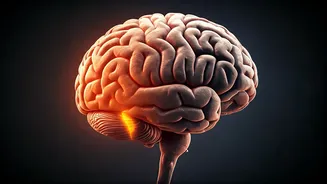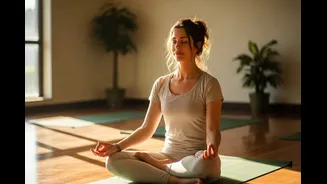Introduction to Yoga
Yoga, a practice originating thousands of years ago in India, combines physical postures (asanas), breathing techniques (pranayama), and meditation. It
is renowned for its capacity to improve physical and mental health. The core of yoga lies in its holistic approach. This promotes not just physical flexibility and strength but also mental clarity and emotional balance. Many people overlook the significant impact of yoga on cognitive functions, notably memory and concentration. These ancient yoga poses, when practiced consistently, can help to enhance these mental capabilities, leading to improved overall cognitive performance. The beauty of these poses is in their simplicity. They can be performed with minimal equipment and space, making them accessible to anyone. Their focus on mindful movement and deep breathing helps to calm the mind, reduce stress, and improve focus, all of which are essential for better memory retention and recall. Incorporating these poses into a daily routine can be a transformative step towards sharper mental acuity and a more focused life. This section will introduce these six ancient poses.
Tadasana (Mountain Pose)
Tadasana, or Mountain Pose, is often considered the foundation of all standing yoga poses. It seems simple, but it is incredibly powerful for developing awareness and grounding. To perform this pose, stand tall with your feet together, or slightly apart, and your arms relaxed at your sides. Focus on aligning your body: your feet firmly planted on the ground, your legs engaged, your spine straight, your shoulders relaxed, and your head in a neutral position. Engage your core, and lift the crown of your head towards the ceiling, elongating your spine. Close your eyes if that helps, and concentrate on your breath – inhale deeply, feeling your body expand, and exhale fully, releasing tension. Tadasana is not just about physical posture; it's about mental stillness. It helps to calm the mind and cultivate a sense of presence. The pose demands focus and awareness of the body. By grounding the body, this pose allows the mind to settle, increasing your ability to concentrate. This is important for memory because memory is often impacted by stress and a scattered mind. Mountain pose is a way to quieten that and improve focus.
Uttanasana (Standing Forward Bend)
Uttanasana, or Standing Forward Bend, is known for its calming effect on the brain. To get into this pose, begin in Tadasana. Inhale deeply, and as you exhale, bend forward from your hips, keeping your spine straight. Allow your head to hang heavy, relaxing your neck. If you can, reach your hands towards the floor, or hold your elbows. Keep your legs straight, but slightly bent at the knees if needed. This pose helps stretch the spine, which stimulates the central nervous system, promoting mental clarity. The inversion in Uttanasana, where the head is below the heart, is excellent for improving blood flow to the brain, which in turn enhances cognitive function. Increased blood flow ensures the brain gets the required oxygen and nutrients. Doing this will improve cognitive function by reducing mental fatigue and boosting focus. With consistent practice, Uttanasana can promote a calm and focused state of mind, which supports effective learning and memory retention.
Adho Mukha Svanasana (Downward-Facing Dog)
Adho Mukha Svanasana, or Downward-Facing Dog, is one of the most well-known yoga poses, praised for its all-around benefits. Start on your hands and knees, with your hands shoulder-width apart and your knees hip-width apart. Tuck your toes under, and lift your hips up and back, forming an inverted V-shape with your body. Your hands are firmly planted on the ground, and your heels are drawn towards the floor, while your head hangs loosely between your arms. This pose stretches the entire body, especially the spine, hamstrings, and shoulders. Like Uttanasana, Downward-Facing Dog increases blood flow to the brain, improving focus and concentration. The inverted position also helps to relieve stress and calm the mind, creating an environment conducive to learning and memory. This pose can boost energy levels. By practicing Adho Mukha Svanasana regularly, one can cultivate a sense of mental clarity and emotional stability. This can improve overall cognitive performance. This pose is a great way to relieve some stress before a long day of learning and concentration.
Trikonasana (Triangle Pose)
Trikonasana, or Triangle Pose, is excellent for enhancing focus and promoting balance. To perform this pose, stand with your feet wide apart, about 3 to 4 feet. Turn your right foot out 90 degrees and your left foot slightly in. Inhale, and extend your arms out to the sides. Exhale, and bend to your right, reaching your right hand towards your right foot, while your left arm reaches towards the ceiling. Keep your chest open and your gaze towards your upper hand. Trikonasana strengthens the core and improves balance, promoting a sense of mental stability and clarity. The act of holding the pose requires intense focus, which helps to train the mind to concentrate. The posture also stimulates the abdominal organs, which can contribute to reducing stress and improving cognitive function. The combination of physical balance and mental concentration in Trikonasana makes it a beneficial pose for improving memory and concentration. Practicing Trikonasana regularly helps improve overall cognitive function.
Vrikshasana (Tree Pose)
Vrikshasana, or Tree Pose, is a balancing pose that greatly enhances focus and mental stability. To do this, stand tall in Tadasana. Shift your weight to your left leg, and bring the sole of your right foot to the inside of your left thigh (avoiding the knee). Find your balance by fixing your gaze on a point in front of you (drishti). Bring your hands to your chest in prayer position or extend them overhead. This pose demands that you concentrate intently on maintaining balance, which helps to sharpen focus and calm the mind. The steadiness required in Vrikshasana helps to build mental resilience and improves the ability to manage distractions. Regular practice helps to enhance the ability to focus and improves the working memory, which is essential for learning and remembering information. Tree pose is a great way to bring focus and clarity into your day, and it can be a great addition to your routine.
Pranayama and Meditation
While not a specific pose, Pranayama (breathing exercises) and meditation are vital components of any yoga practice, especially for enhancing memory and focus. Simple breathing exercises like deep belly breathing (Dirgha Pranayama) can calm the nervous system, reduce stress, and improve oxygen flow to the brain. Begin by sitting comfortably, closing your eyes, and taking slow, deep breaths, inhaling through the nose and exhaling through the mouth. Meditation helps train the mind to focus and increases awareness. Try short guided meditations, where you concentrate on your breath or a specific mantra. These practices reduce mental clutter, helping to improve attention span and memory retention. Meditative practices allow you to calm your mind and focus on the present moment, increasing concentration, which is essential for cognitive enhancement. Incorporating pranayama and meditation into a daily routine, even for just 5-10 minutes, can significantly improve cognitive functions.














